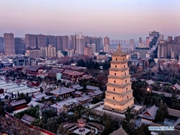

The Hong Kong-Zhuhai-Macao Bridge and tunnel seen on Sunday, as final preparations were made for its opening on Wednesday. [Photo by Vincent Chan/ for China Daily]
The 55-kilometer Hong Kong-Zhuhai-Macao Bridge, scheduled to open for traffic on Wednesday, will provide a crucial boost to the development of the Guangdong-Hong Kong-Macao Greater Bay Area, analysts said.
As the first road link to span the Pearl River Estuary, the bridge and tunnel will energize the regional economy and integrate cities from both sides of the estuary into one dynamic community.
The Bay Area, in the Pearl River Delta, encompasses nine cities in Guangdong province plus the two special administrative regions of Hong Kong and Macao.
Last year, the total GDP of those 11 cities reached 11.7 trillion yuan ($1.69 trillion). That means 5 percent of the nation's population contributed over 14 percent of country's GDP in 2017.
Like the San Francisco Bay Area in the United States, the strategy behind the development of the Bay Area in China was to merge the 11 cities into a world-class city cluster, able to compete on a global scale.
"The HZMB is one of the most important elements of the development of the Bay Area," said Jason Ni Mengcheng, an assistant professor in the Department of Architecture and Civil Engineering at City University of Hong Kong. Ni specializes in research into large transportation infrastructure.
 |

 Award-winning photos show poverty reduction achievements in NE China's Jilin province
Award-winning photos show poverty reduction achievements in NE China's Jilin province People dance to greet advent of New Year in Ameiqituo Town, Guizhou
People dance to greet advent of New Year in Ameiqituo Town, Guizhou Fire brigade in Shanghai holds group wedding
Fire brigade in Shanghai holds group wedding Tourists enjoy ice sculptures in Datan Town, north China
Tourists enjoy ice sculptures in Datan Town, north China Sunset scenery of Dayan Pagoda in Xi'an
Sunset scenery of Dayan Pagoda in Xi'an Tourists have fun at scenic spot in Nanlong Town, NW China
Tourists have fun at scenic spot in Nanlong Town, NW China Harbin attracts tourists by making best use of ice in winter
Harbin attracts tourists by making best use of ice in winter In pics: FIS Alpine Ski Women's World Cup Slalom
In pics: FIS Alpine Ski Women's World Cup Slalom Black-necked cranes rest at reservoir in Lhunzhub County, Lhasa
Black-necked cranes rest at reservoir in Lhunzhub County, Lhasa China's FAST telescope will be available to foreign scientists in April
China's FAST telescope will be available to foreign scientists in April